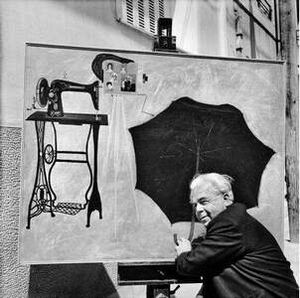Spyros Vassiliou facts for kids
Quick facts for kids
Spyros Vassiliou
|
|
|---|---|

Spyros Vassiliou.
|
|
| Born | June 16, 1903 Galaxidi, Greece
|
| Died | March 22, 1985 (aged 81) |
| Nationality | |
| Education | Athens School of Fine Arts |
| Known for | Painting, illustrations, wood carving, stage and costume designs |
| Children | 2 |
Spyros Vassiliou (born June 16, 1903, died March 22, 1985) was a famous Greek artist. He was a painter, printmaker, illustrator, and also designed sets for plays and movies. He became well-known for his art starting in the 1930s. He won the Benaki Prize from the Athens Academy and a Guggenheim Prize for Greece in 1960. His artworks have been shown in galleries all over Europe, the United States, and Canada.
Contents
Becoming an Artist
Spyros Vassiliou was born in a town called Galaxidi in Greece. When he was 18, in 1921, people from his town collected money to send him to Athens. There, he studied art at the Athens School of Fine Arts. His teachers included Alexandros Kaloudis and Nikolaos Lytras.
In 1929, Vassiliou had his first art show all by himself. A year later, in 1930, he won the Benaki Prize. He received this award for his design of the Saint Dionysios Church in Kolonaki, Athens. During this time, he also helped start two art groups called "Techni" and "Stathmi."
Showing Art Around the World
Spyros Vassiliou's art was shown in many important places. He represented Greece at the Venice Biennale in 1934 and again in 1964. The Venice Biennale is a big international art exhibition. He also showed his work in Alexandria in 1957 and at the São Paulo Art Biennial in 1959.
In 1955, he designed and painted the inside of the Saint Konstantinos Orthodox church in Detroit, USA. In 1960, he won the Solomon R. Guggenheim National Section Award for his painting called "Lights and Shadows." Later in his life, in 1975 and 1983, special shows of his work were held at the National Art Gallery and Alexandros Soutzos Museum in Greece.
Vassiliou's Unique Style
Spyros Vassiliou became known for painting how cities change. He showed the growth of urban areas around his home in Athens, even near the ancient Parthenon. His art often used single-color backgrounds and placed objects in unusual ways.
He honored old Byzantine religious art by floating symbols of everyday Greek life on backgrounds of gold or sea-blue colors. This was similar to how religious symbols appear on gold in traditional icons. He used both oil paints and watercolors to create paintings of nature, city scenes, portraits, and daily life. He mixed ideas from art styles like Cubism and Impressionism. Vassiliou was also one of the first Greek artists to create Pop Art.
Other Creative Work
Besides painting, Spyros Vassiliou was involved in many other creative activities.
Theater and Film Design
For many years, Vassiliou taught about theater. As early as 1927, he started designing sets and costumes for plays. He also worked in movies. Some of his well-known film projects include Michalis Kakoyiannis' 1962 movie Elektra, which starred Irene Papas.
Art During Wartime
During the German occupation of Greece (1941-1945), it was hard to find painting supplies. So, Vassiliou started making engravings and woodcuts. His works from this time, like The Burial of Palamas and The Mourning of the Kalavrytans (both from 1943), became famous in Greece as symbols of freedom. He also illustrated and secretly published three books and made woodcut prints for magazines during these years.
Illustrations and Posters
Over the years, many of Vassiliou's drawings and paintings were used on the covers of books and magazines. These included The Athenian (magazine) and a children's magazine called To Rodi. In To Rodi, he also wrote reviews of children's drawings.
In 1948, the Greek National Tourism Organization used one of Vassiliou's illustrations, "Island of Poros," as a poster to promote Greece to tourists.
Spyros Vassiliou's Legacy
His Home as a Museum
The home and studio of Spyros Vassiliou opened as a museum in June 2004. The Hellenic Ministry of Culture helped make this happen. The museum showed many of his paintings and theater designs in the house where he lived. The building was located near the ancient Odeon of Herodes Atticus and the Acropolis of Athens. However, the museum closed in February 2016.
Preserving His Work
Today, the Spyros Vassiliou Archive is managed by ARTIFEX. This is a non-profit group that works to keep and share Spyros Vassiliou's art with the world.

